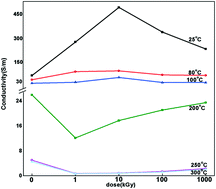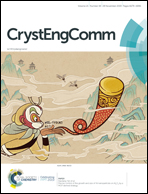γ-Ray dose dependent conductivity of MoS2 nanomaterials at different temperatures
Abstract
In this work, MoS2 nanomaterials were successfully prepared by a simple hydrothermal method. The samples were irradiated with the Co-60 gamma radioisotope at doses of 1, 10, 100, and 1000 kGy, and they were characterised by several analysis techniques. X-ray photoelectron spectroscopy (XPS) analysis showed that γ-ray irradiation did not change the stoichiometric ratio or charge state of MoS2. The X-ray diffraction (XRD) patterns of the irradiated samples showed better crystallinity and decreased average grain size. The transmission electron microscopy (TEM) results also confirmed that MoS2 had better crystallinity after γ-ray irradiation. Raman analysis showed a red-shift of both E12g and A1g modes after γ-ray irradiation. The conductivities of the samples before and after irradiation were investigated at different temperatures. As the test temperature (T) increased, the conductivity of MoS2 monotonously decreased, and it did not change above 250 °C. When T < 100 °C, the conductivity first increased and then decreased with increasing γ-ray dose, reaching a maximum at 10 kGy. When T > 100 °C, the conductivity first decreased and then increased, reaching a minimum at 1 kGy. It is worth noting that the conductivity of the MoS2 nanomaterials was 511.956 S m−1 at 10 kGy γ-ray irradiation at 25 °C, which is almost 6.2 times that of the unirradiated sample at this temperature. This indicates that the conductivity of MoS2 nanomaterials strongly depends on the γ-ray dose and the service temperature. The appropriate dose of γ-ray irradiation can significantly improve the conductivity of MoS2 when used at room temperature.



 Please wait while we load your content...
Please wait while we load your content...